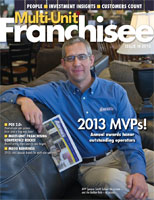Work Order Relief: Track Your Facilities Assets to Save Time and Money
How much maintenance information do you have on all of your locations? Do you know how many of your HVAC units will need to be replaced this year? Are your signs still under warranty? What maintenance is the landlord required to do, and when? How often do your floors need to be stripped and waxed? When should your backflows be tested and fire extinguishers inspected? Do you know how much you are spending on repairs, and are those charges consistent at different locations?
Tracking your facilities maintenance transactions may not be a priority; treating this as a reactive component to your business is standard practice. However, if you believe that your locations are your #1 asset and that maintaining them could lead to more business and a better customer experience, you would want to simplify this process, correct?
If you had a work order management system that was easy to use, you could quickly find all of this information and automate your maintenance programs using the following key features found in work order systems:
- Asset tracking - Each of your locations has assets that must be maintained: HVAC, lighting, floors, stoves, walk-ins, grease traps, signs, etc. However, you need a place to store all the data about these assets. An asset database serves this purpose, allowing you to track serial numbers, colors, square footages, and asset photos. Service history can also be tracked against each asset.
- Vendor management - You spend time finding the right vendors to service your locations. Why not capture all their information in one centralized system so you have their contact information, insurance documents (with you listed as additionally insured), certifications, and price lists in one place? A work order management system will track how many times they have been to your location, the work performed, the amount charged, and any warranties they offer.
- Service dispatch - When an issue happens at one of your locations, your managers will have a centralized system with a list of prequalified vendors. If the system is set up right, NTEs (Not To Exceeds) are built into the vendor records so that every vendor knows they cannot charge more than the NTE without permission from either the manager or corporate. The system generates a work order and alerts them to the problem, leaving a paper trail. The IVR (Interactive Voice Response) system requires vendors to check in and check out, which allows you to track whether they are at your location and how long they are there. When the vendor hands you an invoice, you now have more knowledge about its accuracy. Plus, you will have a record if the repair doesn't "take" and you need to bring them back for a recall.
- Program automation - Maintenance programs can be placed on a "set and forget" program in your system and automatically generate work orders based on the frequency you've determined. For example, if you want your windows cleaned both inside and out each month, a work order will be auto-dispatched to your provider each month. If you want a quarterly HVAC preventive maintenance program or a monthly grease-trap pumping program, all of that can be automated through a work order management system.
- Accounts payable - Most work order management systems have modules that require vendors to input their information, leaving less administrative work for you. Each work order is updated with "actual" work completed and converted to an invoice in your system for approval based on the fees you pre-negotiated.
- Reporting - The last critical component is to ensure that your system can generate reports to help you run your business. To support you in making future business decisions, these reports should provide the option to break down the information by location, trade, or asset. Most work order management systems have an automated function that will send pre-designed reports directly to your inbox at whatever frequency you want. Reports could include financial information, budgets vs. actuals, type of repair, vendor time on site, and open quotes.
An investment in an asset tracking and work order management system is a strategic decision for multi-unit owners who want to ultimately save time and money. Using these systems, operators are able to make more informed and cost-effective decisions for their equipment and building maintenance with regard to repairs, extended asset life, and replacements.
 Kellie D'Andrea is president of NEST International, a facility maintenance management firm. A former franchise owner, her passion is taking businesses to the next level. She is on the board of the Professional Retail Store Maintenance Association. She can be reached at 800-611-6378 or [email protected].
Kellie D'Andrea is president of NEST International, a facility maintenance management firm. A former franchise owner, her passion is taking businesses to the next level. She is on the board of the Professional Retail Store Maintenance Association. She can be reached at 800-611-6378 or [email protected].
Share this Feature
Recommended Reading:
FRANCHISE TOPICS
- Multi-Unit Franchising
- Get Started in Franchising
- Franchise Growth
- Franchise Operations
- Open New Units
- Franchise Leadership
- Franchise Marketing
- Technology
- Franchise Law
- Franchise Awards
- Franchise Rankings
- Franchise Trends
- Franchise Development
- Featured Franchise Stories
FEATURED IN

Multi-Unit Franchisee Magazine: Issue 3, 2013

$1,000,000
$100,000





 The multi-unit franchise opportunities listed above are not related to or endorsed by Multi-Unit Franchisee or Franchise Update Media Group. We are not engaged in, supporting, or endorsing any specific franchise, business opportunity, company or individual. No statement in this site is to be construed as a recommendation. We encourage prospective franchise buyers to perform extensive due diligence when considering a franchise opportunity.
The multi-unit franchise opportunities listed above are not related to or endorsed by Multi-Unit Franchisee or Franchise Update Media Group. We are not engaged in, supporting, or endorsing any specific franchise, business opportunity, company or individual. No statement in this site is to be construed as a recommendation. We encourage prospective franchise buyers to perform extensive due diligence when considering a franchise opportunity.